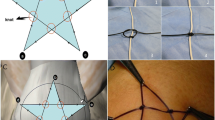Abstract.
The eccentric ventral AO tension belt system represents the standard therapy of fractures of the patella. This often leads to unsatisfying results. Relating to Klute and Meenen [10] and the results of our own retrospective study, expressed as a percentage, 5–34 % (own results 12.4 %) have extremely poor treatment outcome, 23–60 % (39 %) end in deficiencies of bending, and there are 51–79.5 % (65.7 %) with subjective complaints after patella osteosynthesis. The disadvantages due to the eccentric tension belt position and the impossibility of applying the tension belt directly to the bone surface are abolished with the development of the XS nail. Due to its central position, constant compression of the entire fracture surface is provided. This is valid for all tension-stressed fractures such as those of the patella and olecranon. In synthetic patellae [5] standardized stress testing with changing tension up to 500 Newton was carried out. The XS nail was compared with the AO tension belt osteosynthesis after osteotomy and osteosynthesis in synthetic patellae. The XS nail was superior to the tension belt for all tests and therefore can be applied to all types of fractures where tension stress exists. We repaired the first 15 patella fractures with the XS nail. In 13 of 15 cases, full load of the injured leg was possible (for stairs a plaster splint was used). The experimental patella tests and first clinical results with the XS nail osteosynthesis after patella fracture confirm the new type of osteosynthesis, and functional treatment with loading seems possible.
Zusammenfassung
Die exzentrische ventrale Zuggurtung stellt die Standardtherapie der Patellafraktur dar. Dabei kommt es häufig zu unbefriedigenden Ergebnissen. Nach Klute und Meenen [10] und Ergebnissen einer eigenen retrospektiven Studie bestehen in 5–34 % (eigene: 12,4 %) sehr schlechte Behandlungsergebnisse, in 23–60 % (39 %) Beugedefizite und in 51–79,5 % (65,7 %) subjektive Beschwerden nach Patellaosteosynthese. Durch die Entwicklung eines Kleinfragmentzuggurtungskompressionsnagels (XS-Nagel), der durch seine zentrale Lage eine gleichmäßige Kompression der gesamten Frakturfläche bei allen zugbelasteten Frakturen wie Patella und Olecranon ermöglicht, werden die Nachteile durch die exzentrische Zuggurtungsschlingenlage und die Unmöglichkeit der Führung der Zuggurtungsschlinge direkt auf der Knochenoberfläche beseitigt. In einer eigenen experimentellen Studie [5] wurden an Kunststoffpatellae standardisierte Wechseldruckbelastungen bis 500 Newton durchgeführt. Hierbei wurde der XS-Nagel mit der Zuggurtungsosteosynthese an osteotomierten Kunststoffpatellae verglichen. Der XS-Nagel war der Zuggurtungsosteosynthese in allen Versuchen überlegen und ist somit bei allen zugbelasteten Frakturformen anwendbar. Die ersten 15 Patienten mit Patellafrakturen wurden in unserer Klinik mit dem XS-Nagel versorgt. Alle Patienten wurden postoperativ bis 90 °-Knieflexion aktiv frei beübt, und 13 der 15 Patienten wurden ohne Tutorschutz vollbelastet (Treppensteigen war ohne Tutorschutz nicht erlaubt). Die experimentellen und ersten günstigen klinischen Ergebnisse nach Osteosynthese von Patellafraktur durch den XS-Nagel erlauben eine funktionelle Behandlung mit Belastung.
Similar content being viewed by others
Author information
Authors and Affiliations
Rights and permissions
About this article
Cite this article
Gehr, J., Friedl, W. Probleme der Zuggurtungsosteosynthese von Patellafrakturen und deren Konsequenzen für weitere Implantatentwicklungen Der XS-Nagel. Chirurg 72, 1309–1318 (2001). https://doi.org/10.1007/s001040170037
Issue Date:
DOI: https://doi.org/10.1007/s001040170037




